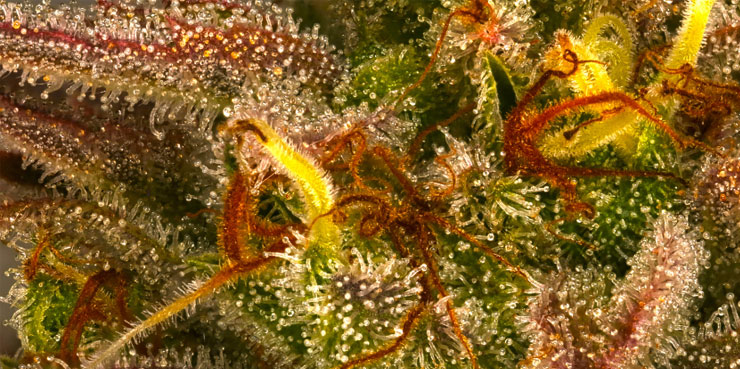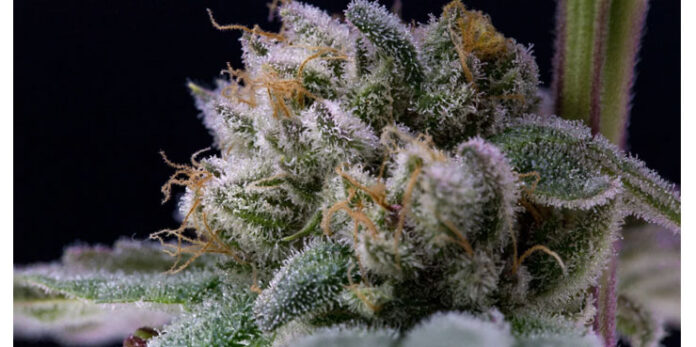There are a variety of important parts that make up the cannabis plant. With major compounds such as delta-9-tetrahydrocannabinol and cannabidiol, which have opposing effects, among various other compounds, cannabis scientists are constantly discovering new ways to get the most out of the plant.
Probably one of the most important parts is one that not many know about, and that’s trichomes. Trichomes are those delicious-looking little hairs or crystals that you see when you take a look at your cannabis flower or leaves, and can often leave sticky residue on your fingers afterward.
What Are Trichomes?
“Trichomes, they’re like the rockstars of the cannabis world — where all the action happens,” says Holly Hillyer, founder and CEO of Utokia Farms LLC and Utokia Herb Co. “These tiny, hair-like structures on cannabis buds and leaves are packed with THC, CBD and loads of other cannabinoids and terpenes. They’re the reason why buds look so frosty or crystally and smell so darn good.”
Now, let’s break it down a bit more: you’ve got your bulbous trichomes — those sneaky little guys you can’t even see without a microscope — and then there are the capitate-sessile trichomes. These are slightly bigger and mushroom-shaped, but still pretty elusive, according to Hillyer.
“But the real headliners? The capitate-stalked trichomes. You can’t miss these – they’re like the celebrities of the trichome world, shining with resin and boasting the highest concentration of cannabinoids and terpenes. And guess what? Most of the good stuff’s in their heads,” she says.
Their heads, or cuticles (the bulbous part at the top of the trichome), is where all of these goodies are enclosed. According to David Sandelman, COO, CTO and co-founder of Cannatrol, as long as the cuticle remains intact during the post-harvest process of drying and curing, the flower will be of high quality and potency.
“If the cuticle becomes damaged or ruptured, which can be caused by handling or improper environmental control when subjected to fluctuations in vapor pressure, the terpenes and cannabinoids are released and lost,” he says.
The Functions of Trichomes
As stated in a HashDash article, trichomes on the cannabis plant act as a defense mechanism to ward off predators. These glands can be found in different forms on various plant species in the natural world including algae and various bulbous flowers like orchids. For instance, if you’ve ever seen a carnivorous plant like a venus flytrap, its tiny hair trichomes signal that prey is lurking and that it’s time for dinner.
“Trichomes serve various functions including protection against herbivores and insects, regulation of leaf temperature (they are like little sunshield umbrellas for the bud) and attraction of beneficial insects like ladybugs and lacewings,” Hillyer notes.

Assisting With Harvest Timing
When it comes to harvest timing, observing trichomes with a microscope is key, according to Hillyer. Initially clear, they gradually turn milky/cloudy and then amber as they mature. Cloudy trichomes signify peak cannabinoid content.
“We aim for about 70-80% milky/cloudy trichomes for harvest,” notes Hillyer. “Amber trichomes suggest THC conversion into CBN, leading to decreased potency and a more relaxing effect (couch lock). Balancing the harvest to include predominantly cloudy trichomes is crucial since different trichomes mature at varied rates due to light exposure and position on the plant.”
Early harvesting may yield more potent buds, but could sacrifice overall yield and lead to a racy feeling high.
Trichomes’ Role in Potency Testing
Since trichomes are where cannabinoids such as THCA and CBDA are stored, and these are the primary compounds tested from state to state as the active ingredient in finished cannabis products, they play a crucial role in potency testing.
“From a market standpoint, cannabinoids have also proven to be a key driver in sales both at the consumer level and in wholesale markets,” comments C3 Industries’ Vice President of Operations Andrew (“AJ” ) Bodkin, Esq. “Cultivators typically focus on yield data when discussing the economic potential of a garden, whereas trichome production potency is equally important in turning product into dollars.”
However, Hillyer explains that trichomes’ role is complicated even after harvesting. Trichomes continue to age and break down even after the plant is hung and dried. Oxygen and light both degrade THC as it continues to convert THC into CBN, so when a lab potency tests a bud, it’s going to be different on the test date vs. days, weeks or even months later.
“Trichome development and cannabinoid concentration can also vary within a single plant,” she continues. “A single sample might not capture the full range of potency across the entire batch. There are issues with lab inconsistencies, plant variability and timing that all make potency testing look fraudulent when it really isn’t accurate.”
Furthermore, there’s terpenes and hundreds of other cannabinoids that make up what we call the entourage effect that can influence how high the person feels and what other effects they get, according to Hillyer.
How to Boost Production
Since trichomes play such a crucial role in the cannabis plant, you’re probably wondering the best ways to boost its production and get the most cannabinoids. While genetics play perhaps the biggest role in how many trichomes a plant will have, according to Hillyer, there are a few things you can do to either maximize production or even boost it:
- Make sure your plants are free of pathogens and bugs. The Hop Latent Viroid is a devastator to trichome production and has really gotten out of control in gardens. Bugs like spider mites and thrips can also feed on the plant leaves and pierce the trichome heads, ultimately damaging them.
- Keep environments and nutrients in check. Proper lighting, temperature, humidity and sufficient nutrients will keep the plant performing at its peak and not diverting resources into survival vs. trichome production.
- Keep stress to a minimum. Since trichomes are produced to protect the plant, some stress can be a good thing, but you need a balance. Too much stress can be detrimental, but a little can sometimes boost results.
- Switch to LED lighting. The type of light can greatly influence trichome production and maturation. Hillyer switched from HPS (high pressure sodium) to LED and saw a massive increase in trichomes, as well as more mature trichomes.
“Feeding the plant a proper diet with a highly controlled environment is paramount in the pursuit of increased trichome production,” adds Bodkin. “Additionally, proper processing after the plant is harvested will help ensure you maintain all the trichomes that you have worked so hard to produce.”











